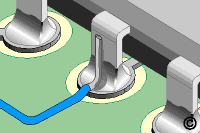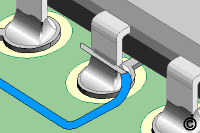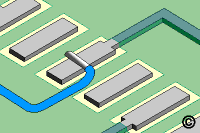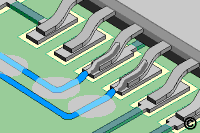No. 6.1
Jumper Wires
OUTLINE
This procedure covers the repair/modification of printed boards and electronic assemblies by the use of jumper wires to complete electrical continuity between two points. This procedure is meant to provide a foundation for adding jumper wires during the repair/modification process. The techniques and guidelines are based on general commercial and industry practices.
Jumper wires fall into three (3) categories
- Those that are considered wires and are installed during assembly. The routing, termination, and bonding of these jumper wires are documented by engineering instructions or drawing notations.
- Those that are added after assembly to effect a change or modification. The routing, termination, and bonding of these jumper wires are documented by engineering change notice instructions or drawing notations.
- Those that are added to correct a defect.
This procedure has 9 main sections.
- References
- Tools and Materials
- General Rules
- PC Board Preparation
- Jumper Wire Selection
- Jumper Wire Preparation
- Jumper Wire Termination and Routing
- Jumper Wire Bonding
- Jumper Wire Termination Figures
| ACCEPTABILITY REFERENCES |
| IPC-A-610 |
11.0 |
Discrete Wiring |
TOOLS & MATERIALS
Adhesives
Cleaner
Cutters
Flux, Liquid
Pliers
Solder
Solder Iron
Tape Dots
Wipes
Wire
Wire, Adhesive Coated
Wire Strippers
GENERAL RULES
- Jumper wires should be placed on the component side of the assembly or printed board unless otherwise specified.
- Jumper wires shall be routed in an XY manner as directly as feasible, making as few bends as possible. See Figure 1.
- Jumper wires shall not be raised more than 3.2 mm (.125") inch above the board surface or not above components or leads in such a way that they will interfere with circuit board mounting.
- Bare conductor jumper wires longer than 12.7 mm (0.50") shall not be used. Bare conductor jumper wires shorter than 12.7 mm (0.50") shall not violate the minimum electrical clearance.
NOTE
The 12.7 mm (0.50") dimension refers to the length between terminations.
- Jumper wires may pass over lands provided sufficient slack is available so that the wire can be moved away from the land for component replacement. Jumper wires shall not pass over pads or vias used as test points.
- Jumper wires shall not be routed under or over component leads or component bodies. Contact with heat sinks must be avoided.
- Jumper wires shall not pass through component foot prints unless the layout of the assembly prohibits the routing in other areas.
- Jumper wires shall have stress relief.
- Jumper wires may be routed through plated through holes provided the wire is insulated and insulation sleeving is placed in the hole. If a hole is needed, use the following method. See Figure 2.
- Drill a hole .25 mm (.010") larger than the insulation diameter.
- Inspect the hole for burs or exposed internal circuits.
- Document the added hole on a control drawing.
NOTE
Be careful that the drilled hole does not interfere with surface and internal conductors.
- Jumper wires soldered into plated through holes must be discernible on the opposite side.
- Jumper wires soldered to lifted or clipped component leads may require insulation to prevent shorting. See Figure 3.
- Jumper wires may be terminated by a variety of methods. See illustrations.
PC BOARD PREPARATION
- Clean the area.
NOTE
When wires are in place cleaning will often be more difficult.
- Remove coating material or oxidization as necessary from the component leads, pads, or conductors where wire terminations will be soldered. Clean the area.
- Remove solder from the connection point if needed. Clean the area.
- Measure approximately the length of each wire needed.
JUMPER WIRE SELECTION
- Bare conductor jumper wires longer than 12.7 mm (0.50") shall not be used. Bare conductor jumper wires shorter than 12.7 mm (0.50") shall not violate the minimum electrical clearance.
NOTE
The 12.7 mm (0.50") dimension refers to the length between terminations.
- Silver plated wire must not be used; under some conditions corrosion of the wire can occur.
- The smallest diameter wire that will carry the required current should be selected.
- Insulation requirements of the wire should withstand soldering temperatures, have some resistance to abrasion, have a dielectric resistance equal to or better than the board insulation material.
- Recommended wire is solid insulated copper wire, tin lead plated, 22 to 32 AWG with Kynar, Milene, Kapton, Teflon or equivalent insulation.
CAUTION
Wires with nicked or damaged conductors should not be used.
JUMPER WIRE PREPARATION
-
Cut the jumper wires approximately 12.7 mm (0.50") longer than the estimated length needed.
NOTE
The length and gauge of the jumper wire may be critical. All wires have an electrical resistance (impedance) to the flow of electricity. This impedance is important to electronic circuitry. Always refer to wiring lists for specific jumper wire requirements.
-
Strip insulation from each end of the jumper wire.
NOTE
Strip length is dependent on the termination style.
-
If required, tin the stripped ends with solder. Clean if necessary.
JUMPER WIRE TERMINATING AND ROUTING
-
Form the wire as needed and place the wire in position depending on the termination style. Center the wire on the component lead or pad, do not overhang sides. If the wire is soldered to a pin, terminal or component lead, wrap the wire a minimum of 90°.
-
Solder one end of the wire. Clean if necessary.
NOTE
Solder joint length must meet acceptability requirements.
CAUTION
The insulation shall not be stripped back more than 2 wire diameters from the solder joint. Wire insulation may touch but not penetrate the solder joint provided proper wetting of the wire is evident.
-
Bend the wire as needed and run the wire along board surface. Route the jumper wire using the shortest route in an XY direction with the fewest possible bends to the second termination point.
NOTE
Jumper wires shall not be routed under or over component leads or component bodies. Contact with heat sinks must be avoided.
CAUTION
Do not bend the wire tighter than a radius of 3 times the conductor diameter.
-
After routing the jumper wire, solder the opposite end. Clean if necessary.
CAUTION
Wires soldered to lifted or clipped components leads may require insulation to prevent shorting.
JUMPER WIRE BONDING
-
After the wire has been soldered at both ends and cleaned if necessary, the wire should be bonded to the board surface.
NOTE
Bonding is not required if wire is insulated and insulated length is less than 25 mm (1.00").
-
Bond the jumper wire using one of the following methods.
-
Tape Dots or Tape Strips. See Figure 4.
-
Quick Set Adhesive. See Figure 5.
-
Hot Melt Adhesive. See Figure 5.
-
Hot Bonding. Some jumper wires are manufactured with a special thermo-set adhesive coating and are thermally bonded to the board surface with a special bonding tool. See Figure 6.
-
Bond the jumper wire within 6.0 mm (0.25") of each solder joint.
-
Bond the jumper wire within 6.0 mm (0.25") of each bend in the wire.
-
Bond the jumper wire at intervals not less than 25 mm (1.00") on straight runs.
Table 1 - Jumper Wire Termination Methods
| Figure |
Type |
Wire Termination Method |
Accept. |
| 10 |
PTH Hole |
Wire soldered into plated through hole on component side. * |
A |
| 11 |
PTH Lead |
Wire soldered parallel to component lead on component side. |
A |
| 12 |
PTH Hole |
Wire soldered into plated through hole on solder side. * |
A |
| 13 |
PTH Hole |
Wire wrapped around component lead on solder side. |
A |
| 14 |
PTH Hole |
Wire wrapped around component lead on component side. |
A |
| 15 |
PTH Lead |
Wire soldered to lifted component lead. + |
A |
| 16 |
PTH Lead |
Wire soldered to clipped component lead on component side. + |
A |
| 17 |
PTH Lead |
Wire looped and soldered to adjacent component leads. |
A |
| 18 |
PTH Lead |
Wire soldered to component lead, wire running over component. |
NR |
| 19 |
PTH Lead |
Wire soldered perpendicular to component lead. |
NR |
| 20 |
PTH Lead |
Multiple wires soldered to component lead overhanging edge. |
NR |
| 21 |
Chip |
Wire soldered to pad, parallel or perpendicular to component. |
A |
| 22 |
Chip |
Wire soldered parallel or perpendicular to component lead. |
A |
| 23 |
Chip |
Wire soldered to component end, lifted off pad. |
A |
| 24 |
Chip |
Multiple wires soldered to component end overhanging edge. |
NR |
| 25 |
PTH Hole |
Wire soldered into plated through hole. * |
A |
| 26 |
PTH Pad |
Wire soldered across top of PTH pad. |
A |
| 27 |
PTH Pad |
Multiple wires soldered to pad overhanging pad edge. |
NR |
| 28 |
Conductor |
Wire soldered parallel to conductor, contact, SMT pad. |
A |
| 29 |
Conductor |
Wire soldered perpendicular to conductor, contact, SMT pad. |
NR |
| 30 |
Conductor |
Multiple wires soldered to conductor, contact, SMT pad. |
NR |
| 31 |
J Lead |
Wire soldered parallel to component lead. |
A |
| 32 |
J Lead |
Wire soldered to clipped component lead. + |
A |
| 33 |
J Lead |
Wire looped and soldered to adjacent component leads. |
A |
| 34 |
J Lead |
Wire soldered to component lead, wire running over component. |
NR |
| 35 |
J Lead |
Wire soldered perpendicular to component lead. |
NR |
| 36 |
J Lead |
Multiple wires soldered to component lead overhanging edge. |
NR |
| 37 |
J Lead |
Wire soldered to lifted component lead. |
NR |
| 38 |
Gull Wing |
Wire soldered parallel to component lead. |
A |
| 39 |
Gull Wing |
Wire soldered to lifted component lead. + |
A |
| 40 |
Gull Wing |
Wire soldered to clipped component lead. + |
A |
| 41 |
Gull Wing |
Wire looped and soldered to adjacent component leads. |
A |
| 42 |
Gull Wing |
Wire soldered to component lead, wire running over component. |
NR |
| 43 |
Gull Wing |
Wire soldered perpendicular to component lead. |
NR |
| 44 |
Gull Wing |
Multiple wires soldered to component lead overhanging edge. |
NR |
A - Acceptable
NR - Not Recommended
* Jumper wires soldered into plated through holes must be discernible on the opposite side.
+ Jumper wires soldered to lifted or clipped component leads may require insulation to prevent shorting.
| Jumper Wire Termination Figures - Through Hole Components |

Figure 10 - Acceptable Wire soldered into plated through hole, component side.
|
|

Figure 11 - Acceptable Wire soldered parallel to component lead on component side.
|

Figure 12 - Acceptable Wire soldered into plated through hole on solder side. *
|
|

Figure 13 - Acceptable Wire wrapped around component lead on solder side.
|

Figure 14 - Acceptable Wire wrapped around component lead on component side.
|
|

Figure 15 - Acceptable Wire soldered to lifted component lead. +
|

Figure 16 - Acceptable Wire soldered to clipped component lead on component side.
|
|

Figure 17 - Acceptable Wire looped and soldered to adjacent component leads.
|

Figure 18 - Not Recommended Wire soldered to component lead, wire over component.
|
|

Figure 19 - Not Recommended Wire soldered perpendicular to component lead.
|

Figure 20- Not Recommended Multiple wires soldered to lead overhanging edge.
|
* Jumper wires soldered into plated through holes must be discernible on the opposite side.
+ Jumper wires soldered to lifted or clipped component leads may require insulation to prevent shorting.
|
Jumper Wire Termination Figures - Chip Components, Pads and Conductors |

Figure 21 - Acceptable Wire soldered to pad, parallel or perpendicular to component.
|
|

Figure 22 - Acceptable Wire soldered parallel or perpendicular to component.
|

Figure 23- Acceptable Wire soldered to component end, lifted off pad.
|
|

Figure 24 - Not Recommended Multiple wires overhanging pad edge.
|

Figure 25- Acceptable Wire soldered into plated through hole. *
|
|

Figure 26- Acceptable Wire soldered across top of PTH pad.
|

Figure 27 - Not Recommended Multiple wires soldered to pad overhanging pad edge.
|
|

Figure 28 - Acceptable Wire soldered parallel to conductor, contact, SMT pad.
|

Figure 29- Not Recommended Wire soldered perpendicular to conductor, contact, SMT pad.
|
|

Figure 30 - Not Recommended Multiple wires soldered to conductor, contact, SMT pad.
|
* Jumper wires soldered into plated through holes must be discernible on the
opposite side.
+ Jumper wires soldered to lifted or clipped component leads
may require insulation to prevent shorting.
Jumper Wire Termination Figures - J Lead Components

Figure 31 - Acceptable Wire soldered parallel to component
lead.
|
|

Figure 32- Acceptable Wire soldered to clipped component lead. +
|

Figure 33 - Acceptable Wire looped and soldered to adjacent component
leads.
|
|

Figure 34 - Not Recommended Wire soldered to component lead, wire over
component.
|

Figure 35 - Not Recommended Wire soldered perpendicular to component
lead.
|
|

Figure 36 - Not Recommended Multiple wires soldered to lead overhanging
edge.
|

Figure 37 - Not Recommended Wire soldered to lifted component
lead.
|
* Jumper wires soldered into plated through holes must be discernible on the
opposite side.
+ Jumper wires soldered to lifted or clipped component leads
may require insulation to prevent shorting.
| |
|
Solutions Across the Board
TM
|
|
|
|
Product Class: R/F/W/C
Skill Level: Intermediate
Conformance Level: N/A
Revision: E
Revision Date: Jul 7, 2000
Repair Service Charge

Jumper Wires

Figure 1: Route jumper wires in an XY manner as directly as feasible,
with as few bends as possible.

Figure 2: Use sleeving when inserting jumper wires through plated through
holes

Figure 3: Jumper wires soldered to lifted or clipped component leads may
require insulation.

Figure 4: Jumper wires may be bonded to the board surface using tape
dots or tape strips.

Figure 5: Jumper wires may be bonded to the board surface using quick set adhesive or hot
mel

Figure 6: Adhesive coated jumper wires are heat bonded to the board
surface with a special
bonding tool.
|
Tricks of the Trade
We prefer to use Tape Dots
whenever possible to bond wires.
No other wire bonding method is as neat, or as easy to change as Tape Dots.
|
|
|











































